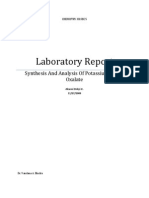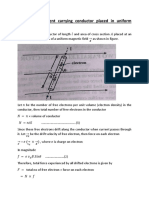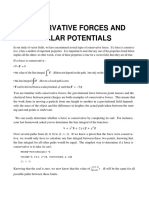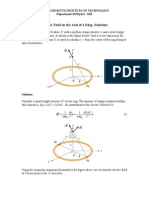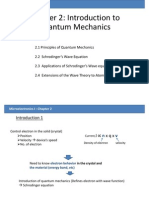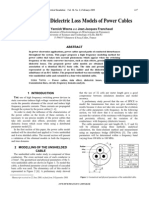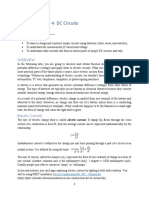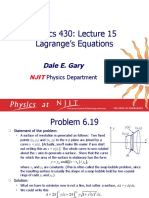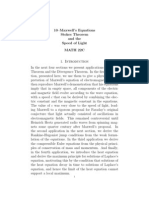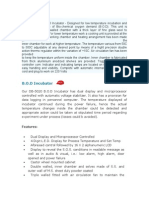A - Phys102 - Lab 1 - Coulomb's Law
A - Phys102 - Lab 1 - Coulomb's Law
Uploaded by
triley89Copyright:
Available Formats
A - Phys102 - Lab 1 - Coulomb's Law
A - Phys102 - Lab 1 - Coulomb's Law
Uploaded by
triley89Original Title
Copyright
Available Formats
Share this document
Did you find this document useful?
Is this content inappropriate?
Copyright:
Available Formats
A - Phys102 - Lab 1 - Coulomb's Law
A - Phys102 - Lab 1 - Coulomb's Law
Uploaded by
triley89Copyright:
Available Formats
PHYS-102 LAB-01
Coulombs Law
1. Objective
The objective of this experiment is to demonstrate that the force between two
stationary charges is directly proportional to the product of the charges and
inversely to the square of the distance between them.
2. Theory
According to Coulombs Law, the magnitude of the electrostatic force between two
charged particles with charges Q
1
and Q
2
and separated by a distance r is given
by:
1 2
2 e
QQ
F k
r
= [1]
Where k = 8.99x10
9
N.m
2
/C
2
is the Coulomb constant. The unit of charge is taken as a
Coulomb (C). The constant k is also written as k = 1/4
o
where the constant
o
is
called the permittivity of free space
o
= 8.854x10
-12
C
2
/ N.m
2
. Since force is a
vector quantity, in the vector form Coulombs law is expressed as:
Figure 1. The free body force diagram of two charged particles.
Where
12
is a unit vector directed from Q
1
to Q
2
.
3. Experimental Procedure
The basis of this experiment is very simple. Two graphite-coated spheres are
charged and the force between them is measured. This is done to study the
dependence of the electrostatic force on [1] the separation between the charges
and [2] on the product of the two charges. We will study only the proportionality
of electrostatic force on the separation distance and the product of the charges.
The separation distance dependence is studied by charging the two spheres and
measuring the force between them by varying the distance between the charged
spheres. The charge product dependence is similarly studied by varying the
charge on the two spheres kept at a fixed distance and measuring the resulting
force.
Note: You will measure the force between the two spheres by measuring torque
resulting in a torsion (angular twist) in the wire holding the one of the charged
spheres on a light insulating lever. One end of the wire is fixed were as another
one can be rotated. The amount of rotation is proportional to the force between
the spheres. The torsion balance can be calibrated to precisely determine this
constant of proportionality between deflection (the twist) and the force.
However, in this experiment we will not do so.
3.1 Apparatus
1. A Coulombs Law apparatus with associated accessories. Two views of the
apparatus in schematic form are shown below.
2. A high-voltage power supply.
3. Faraday Ice Pail, charge producers, electrometer and associated accessories
Figures 1a and 1b. Schematic views of the Coulombs Law Apparatus.
3.2 Experimental Procedure
Important precautions
1. The wire in the torsion pendulum is very fragile and should be handled with
utmost caution. Do not adjust screws holding the wire. You should never tap
the sphere attached to the torsion wire from above. Do not touch the
spheres with your bare hands as it can contaminate and damage the spheres
graphite coating.
2. When using the high-voltage power supply, you should never touch
anything except the spheres the high-voltage probe. Do not point the probe
toward any other person or your own body. Use the probe with one hand,
keeping the other hand free. Do not handle the probe if you are wet or are
standing on a wet floor.
3. Discharge and re-charge both spheres before every measurement. Always
charge spheres at maximal distance from each other, afterwards bringing
the sphere on the adjustable support to shorter distances.
Initial setting.
1. Move the sliding base to the 4-cm mark and set the sphere support rod so
that the sliding sphere is very close to but not actually touching the
suspended sphere. Do not readjust the rod for the remainder of the
experiment. 4 cm is the minimal distance between centers of the spheres.
2. Make sure the spheres are fully discharged (touch them with the green
grounded probe) and move the sliding sphere as far as possible from the
suspended sphere. Rotate the torsion dial to align black lines at the counter
weight vane and on the fixed plate (this is null position). Write down the
angle on the torsion dial
0
. This angle is corresponding to zero force
between spheres.
3.3 Distance Dependence
1. With the spheres at maximum distance, charge both the spheres to a
potential of 6 kV, using the red charging probe connected to the High
Voltage Power Supply.
2. Position the sliding support at the 14 cm mark, Adjust the torsion dial as
necessary to balance the forces and bring the pendulum marker to null
position. Record the distance R from the base scale and the angle from the
torsion dial. Each member of the lab group should perform this
measurement separately.
3. Repeat steps 1 and 2 for 10, 9, 8, 7, 6, 5, and 4 cm distance.
4. Plot the distance R as a function of the displacement angle -
0
. Add a
power trendline to fit the data using Excel and include the equation of the
line, as well the R
2
value, on the chart.
3.4 Charge Dependence
1. Charge both spheres to 6kV. Set the sliding sphere to 4 cm and record the
voltage and the displacement angle . (Hint: this was the last reading you
took from the previous section)
2. Discharge both spheres and bring the sliding sphere to the maximal distance.
Recharge both spheres to 5.5 kV bring the sliding sphere to the same
distance of 4 cm as in step 1. Record the voltage and displacement angle .
3. Repeat step 2 for 5, 4.5, 4, 3.5, and 3 kV.
4. Plot the Voltage as a function of the displacement angle . Add a trendline
to fit the data using excel and include the equation of the line, as well the R
2
value, on the chart.
3.5 Correction to the data.
The Coulombs law (eq.[1]) applies to point charges. An isolated charged
conductive sphere will act as a point charge for measurements made outside the
sphere. In the presence of another similar sphere, a redistribution of charge will
take place to minimize the potential energy of the charges. This redistribution of
charge resulting in a deviation from the point charge approximation can be
significant for separation distances comparable to the radii of the spheres. A
correction factor will be used to correct for this deviation. This correction factor is B
= 1- 4[a/R]
3
, where a is the radius of the sphere and R is the separation between two
spheres. To apply the correction to your data simply divide the measured value of
(or
average
) by B. The spheres used in the present Coulomb torsion balance
apparatus have an average radius a = 1.75 cm.
LAB-01 Coulombs Law
Name:_______________________ Sec./Group__________ Date:_____________
4. Prelab
1. Consider a charged metallic spherical shell of radius a = 1.75 cm. The potential at
a distance of r = 6.0 cm from the center of the shell is measured to be 1.5kV. What
is the charge on the shell? Calculate the potential on the surface of the shell.
(Note: V = kQ/r. You may also like to read the chapter of your textbook that
discusses the Electrostatic Potential.)
2. Using an Excel spreadsheet make a plot of force F vs r, where F and r are as
defined in equation [1]. Use Q
1
= Q
2
= 5.0C and vary r from from 0.5 cm to 10 cm
in steps of 0.5cm. Plot F along the vertical axis.
3. Using an Excel spreadsheet make a plot of F vs. Q
1
Q
2
in eq.[1]. Take r = 10.0 cm
and Q
1
= Q
2
vary from 1.0 C to 10.0 C in steps of 1.0 C. Plot F along the vertical
axis.
LAB-01 Coulombs Law
Name:_______________________ Sec./Group__________ Date:_____________
5. Data
5.1 Distance Dependence
V = (v)
R
(in cm.)
(in
deg.)
avg
(in
deg.)
B=1-
4[a/R]
3
corrected
(in
deg.)
LAB-01 Coulombs Law
Name:_______________________ Sec./Group__________ Date:_____________
5.2 Charge Dependence
R = (cm) B =1-4[a/R]
3
V
(in kV)
(in
deg.)
avg
(in deg.)
B=1-
4[a/R]
3
corrected
(in deg.)
6. Analysis
Use the computer to create the two graphs as specified in Procedures 3.3 and 3.4.
Submit these to your lab instructor.
7. JUST FOR THE FUN OF IT
Fun with the Faradays Cage
Often one has to construct large shielded volumes such as rooms in laboratories
where sensitive electronic measurements are to be shielded from external electrical
interference. Such rooms are also crucial when the electronic communication has to
be secured against unauthorized information sharing - also known as spying. Such
electrically shielded regions are called Faraday cages. Michael Faraday used a metal
ice pail to study how the charges distributed themselves when a charged object was
introduced inside the conducting pail (Note: great scientific experiments are often
carried out not by using the fanciest of gadgets, but by imaginatively using
whatever is easily available). You will be repeating Faradays experiment with the
Faraday cage a cylinder made out of wire mesh isolated from and surrounded by
an outer metallic cylinder made from the same wire mesh. Once, say, positively
charged object placed in the inner cage positive charges from inner cage will have
higher energy than before and therefore will try to escape to the outer cage. Thus
difference in potential energy (voltage) will be created. It can be measured by
precision voltmeter (electrometer). The voltage (V) will be proportional to the
charge Observe carefully and have fun.
Experimental Procedure
1. Rub the two charge producers together to create a charge on them.
2. Insert the blue wand into the lower half of the ice pail (the inner cylinder). Make
sure the wand does not touch the surface of the pail. Note the magnitude of the
deflection and its direction (to the right or to the left, or positive or negative).
3. Withdraw the wand from the cage and note the electrometer reading again.
4. Insert the wand again, and let the wand touch the inner surface of the inner
cylinder. Note the electrometer reading. Remove the wand from the inner
cylinder.
5. Ground the ice pail with green wire and then touch the pail again with the wand
from step 4 above. Note the electrometer reading.
6. Repeat step 2 with the white wand (or steps 1 and 2 if you observe very small or
no deflection).
Conclusions:
V
1. What can you conclude from the direction of electrometer deflection in steps 2
and 7 about the polarity of charges on the white and blue wands?
2. What can you conclude from the direction of electrometer deflection in steps 2
and 4 about the polarity of charges on the blue wand and the charge induced on
the outer surface of the ice pail?
3. What can you conclude from step 5 about the charge on the wand? What
happened to the charge?
Make a hypothesis (an educated guess).
Suppose you rub the two wands together as in step 1 of Experimental procedure,
but this time inside the ice pail. What do you think (and why) the reading on the
electrometer would be? Choose from one of the three possible outcomes:
[1] deflection to the right
[2] deflection to the left
[3] no deflection.
Now do the experiment and see if you were right.
You might also like
- Lab Manual Math 209Document75 pagesLab Manual Math 209ReetNo ratings yet
- Lab Report: Electric FieldsDocument5 pagesLab Report: Electric FieldsKobbi Gal100% (9)
- Lab Report (Final Editied)Document8 pagesLab Report (Final Editied)Alexia Channer100% (5)
- Production of Formaldehyde From MethanolDocument200 pagesProduction of Formaldehyde From MethanolSofia Mermingi100% (1)
- Electrical Characteristics of CablesDocument32 pagesElectrical Characteristics of CablesSupakint Suteepichatpunt100% (1)
- Phase Changes With Ice Cream LessonDocument5 pagesPhase Changes With Ice Cream Lessonapi-254334803No ratings yet
- Experiment 2 - Deflection by Electric FieldDocument6 pagesExperiment 2 - Deflection by Electric Fieldyiiviiezz100% (1)
- Balanza de CorrienteDocument4 pagesBalanza de CorrienteeduturizoNo ratings yet
- Lecture19 Faraday's Law Induction Lenz's Law Generators Motional EmfDocument76 pagesLecture19 Faraday's Law Induction Lenz's Law Generators Motional EmfTaqi ShahNo ratings yet
- What Is Electricity?: Going AtomicDocument11 pagesWhat Is Electricity?: Going AtomicLanie Barsaga Borazon100% (1)
- ELECTRON CONFIG-WPS Office - RecoverDocument50 pagesELECTRON CONFIG-WPS Office - RecoverLyca RealNo ratings yet
- 6.3 Magnetic Torque, Moment, MagnetizationDocument42 pages6.3 Magnetic Torque, Moment, Magnetizationannambaka satishNo ratings yet
- Force On A Current Carrying Conductor Placed in Uniform Magnetic FieldDocument3 pagesForce On A Current Carrying Conductor Placed in Uniform Magnetic FieldSamarpan KoiralaNo ratings yet
- Power Source.Document12 pagesPower Source.SaritechNo ratings yet
- E.over.m RatioDocument8 pagesE.over.m Ratiobrain221304No ratings yet
- Electrostatics OneDocument59 pagesElectrostatics OneAkNo ratings yet
- Determination of Young's Modulus of Metal WireDocument5 pagesDetermination of Young's Modulus of Metal WireZaeem Ul IslamNo ratings yet
- Dielectric Properties of SolidsDocument4 pagesDielectric Properties of SolidsNisaNurpertiwiNo ratings yet
- Hall EffectDocument10 pagesHall EffectNidaul Muiz Aufa100% (1)
- Unit4 - Ionic BondDocument16 pagesUnit4 - Ionic BondGeyson Maquine100% (1)
- Hetero JunctionsDocument19 pagesHetero JunctionsAssini Hussain100% (1)
- Magnetic DipolesDocument10 pagesMagnetic DipolesMarina Rukavina100% (1)
- Hydrogen Balmer Series and Rydberg ConstantDocument4 pagesHydrogen Balmer Series and Rydberg Constantflawson0078970100% (2)
- Experiment Photocell6572Document6 pagesExperiment Photocell6572ShubhamNo ratings yet
- Band Theory of Solids: Brajesh Tiwari and R. E. AmritkarDocument9 pagesBand Theory of Solids: Brajesh Tiwari and R. E. AmritkarkapilNo ratings yet
- Photoelectric Effect Problems AnswersDocument1 pagePhotoelectric Effect Problems AnswersLuisa Gardênia Farias100% (2)
- Magnetic FieldDocument12 pagesMagnetic FieldJai Hui100% (1)
- Madelung ConstantDocument8 pagesMadelung Constantsarthak100% (2)
- Magnetic Materials: 3.1 IntroductionDocument49 pagesMagnetic Materials: 3.1 IntroductionCurious ManNo ratings yet
- Conservative Forces and Scalar Potentials: Needs "Vectoranalysis'" Curl X 2, 2 Y Z, Y 2, Cartesian X, Y, ZDocument6 pagesConservative Forces and Scalar Potentials: Needs "Vectoranalysis'" Curl X 2, 2 Y Z, Y 2, Cartesian X, Y, ZAbha Srivastava100% (1)
- Presentation1 090415045351 Phpapp01 - 2Document24 pagesPresentation1 090415045351 Phpapp01 - 2JitendraKumarNo ratings yet
- Interference Michelson InterferometerDocument6 pagesInterference Michelson InterferometerAsa mathewNo ratings yet
- Electric Field On The Axis of A Ring: Solutions: Q Is Lying in TheDocument2 pagesElectric Field On The Axis of A Ring: Solutions: Q Is Lying in TheNarendra KumarNo ratings yet
- Thermal PropertiesDocument73 pagesThermal PropertiesdhrubankaNo ratings yet
- Chapter 4 (Periodic Table)Document46 pagesChapter 4 (Periodic Table)Tunku Hilman Al-nordinNo ratings yet
- Chapter2 Introduction To Quantum MechanicsDocument32 pagesChapter2 Introduction To Quantum MechanicsTahsin MorshedNo ratings yet
- Lesson 5 Work and EnergyDocument18 pagesLesson 5 Work and EnergyanonymousNo ratings yet
- Skin Effect and Dielectric Loss Models of Power Cables 04784562Document8 pagesSkin Effect and Dielectric Loss Models of Power Cables 04784562Gilberto Mejía100% (1)
- Circuit Theory Experiment 2 Lab Report DONE Jen HahnDocument10 pagesCircuit Theory Experiment 2 Lab Report DONE Jen HahnPei Ing100% (1)
- Electric CurrentDocument9 pagesElectric CurrentmerryNo ratings yet
- Module 1 - DESHIDocument93 pagesModule 1 - DESHIRaghupatiNo ratings yet
- 25Document40 pages25physicsdocs67% (6)
- (B.E. Sem-1 G.T.U.) Physics Paper With SolutionDocument19 pages(B.E. Sem-1 G.T.U.) Physics Paper With SolutionNimesh Nakhva83% (6)
- ThermometryDocument11 pagesThermometryAngelo SaysonNo ratings yet
- Characteristics of G.M.Counter by MR - CharisDocument4 pagesCharacteristics of G.M.Counter by MR - CharisCharis Israel Ancha100% (4)
- Load and Line RegulationDocument11 pagesLoad and Line RegulationHelpUnlimited0% (1)
- Physics 1Document150 pagesPhysics 1omletpao100% (1)
- Online Lab 4 - DC CircuitsDocument8 pagesOnline Lab 4 - DC CircuitsSardar Rehan AhmedNo ratings yet
- Lecture 4 Wavefunction NewDocument53 pagesLecture 4 Wavefunction NewkedirNo ratings yet
- Dispersion of Light and Spectral LinesDocument13 pagesDispersion of Light and Spectral LinesvenkatanarasimhaNo ratings yet
- 4.1.unit-4 - Band Theory of Solids - ECE-2 and 3Document16 pages4.1.unit-4 - Band Theory of Solids - ECE-2 and 3Eswar NandamNo ratings yet
- (#3) Direct, Indirect, Ek Diagram, Effective Mass-1Document6 pages(#3) Direct, Indirect, Ek Diagram, Effective Mass-1zubairNo ratings yet
- Physics 430: Lecture 15 Lagrange's Equations: Dale E. GaryDocument16 pagesPhysics 430: Lecture 15 Lagrange's Equations: Dale E. GaryfaniNo ratings yet
- Band GapDocument13 pagesBand Gapit rewaNo ratings yet
- Theory of Small Oscillations andDocument85 pagesTheory of Small Oscillations andSimbar SunRise100% (1)
- Matter Waves: A Moving Body Behaves in Certain Ways As Though It Has A Wave NatureDocument4 pagesMatter Waves: A Moving Body Behaves in Certain Ways As Though It Has A Wave Naturephysics Lover100% (1)
- PHM 601 Question Bank-2018Document4 pagesPHM 601 Question Bank-2018Abhishek YadavNo ratings yet
- Motion in A Straight LineDocument67 pagesMotion in A Straight LineMichael CarnovaleNo ratings yet
- Maxwell's Equations and Stoke's TheoremDocument26 pagesMaxwell's Equations and Stoke's TheoremTuya ErdenejargalNo ratings yet
- Coulombs_LawDocument3 pagesCoulombs_LawAlexx PeterNo ratings yet
- Microsoft Word - Autumn - Classical - Coulomb's LawDocument10 pagesMicrosoft Word - Autumn - Classical - Coulomb's Lawtriley89No ratings yet
- PhysicsDocument7 pagesPhysicssakchhampradhanangNo ratings yet
- Microsoft Word - Autumn - Classical - Coulomb's LawDocument10 pagesMicrosoft Word - Autumn - Classical - Coulomb's Lawtriley89No ratings yet
- 13f Lab 01 Coulombs LawDocument3 pages13f Lab 01 Coulombs Lawtriley89No ratings yet
- Expt 7 - Coulomb's LawDocument3 pagesExpt 7 - Coulomb's LawAshique FarhadNo ratings yet
- Sec 1 Science Mavis Mid Answer BookletDocument3 pagesSec 1 Science Mavis Mid Answer Bookletenna choyNo ratings yet
- NI Tutorial 3782 enDocument4 pagesNI Tutorial 3782 enhiperboreoatlantecNo ratings yet
- Reservoir Rock Properties and Fluid FlowDocument2 pagesReservoir Rock Properties and Fluid Flowtassili17No ratings yet
- Eni Ote GT 32 Tds 7755 - EnuDocument2 pagesEni Ote GT 32 Tds 7755 - EnumvanzijpNo ratings yet
- G ClampDocument3 pagesG ClampFRESKABIO0% (1)
- Radiographs Course Reference WIS 20: RadiographyDocument35 pagesRadiographs Course Reference WIS 20: RadiographyHaytham MohamedNo ratings yet
- Sizing Calculation of General Service PumpsDocument193 pagesSizing Calculation of General Service Pumpsmkha87100% (2)
- A Truly Beautiful MindDocument2 pagesA Truly Beautiful Mindaakash5c02No ratings yet
- A Comparison of Inherent Risk Levels in Asme B31.8 and Uk Gas Pipeline Design Codes PDFDocument13 pagesA Comparison of Inherent Risk Levels in Asme B31.8 and Uk Gas Pipeline Design Codes PDFApril StewartNo ratings yet
- Aakash CPP - 4Document49 pagesAakash CPP - 4Rishi ShuklaNo ratings yet
- Mock AMC 10Document5 pagesMock AMC 10Melinda Villarey SegismundoNo ratings yet
- Hydroseal Series 3500 Pilot Operated Relief ValvesDocument8 pagesHydroseal Series 3500 Pilot Operated Relief Valvesprihartono_diasNo ratings yet
- 9702 s24 Predicted QP 12Document35 pages9702 s24 Predicted QP 12eldaas147No ratings yet
- Physics ProjectDocument13 pagesPhysics ProjectGanesh harkalNo ratings yet
- General Physics - Worksheet II (2024)Document3 pagesGeneral Physics - Worksheet II (2024)merrymesfin87No ratings yet
- Problem Set 11b + SolusiDocument5 pagesProblem Set 11b + SolusiIwenda Yudha ImaniNo ratings yet
- WPS Dissimilar 11.08 MM Max.Document4 pagesWPS Dissimilar 11.08 MM Max.Sripathy50% (2)
- U.FL R SMT 1 (80) - CL0331 0472 2 80 - SpecSheet - 0000266838Document1 pageU.FL R SMT 1 (80) - CL0331 0472 2 80 - SpecSheet - 0000266838Dao Tuan AnhNo ratings yet
- CH 4 PE PipeDocument22 pagesCH 4 PE Pipeanon_104613317No ratings yet
- 1 Trazabilidad de Los Medidores Coriolis en Aplicaciones de Hidrocarburos Fase GasDocument32 pages1 Trazabilidad de Los Medidores Coriolis en Aplicaciones de Hidrocarburos Fase GasChemicalProgrammerNo ratings yet
- CH 4: Manipulator Kinematics: Task Space (X, Y, Z,) Joint SpaceDocument61 pagesCH 4: Manipulator Kinematics: Task Space (X, Y, Z,) Joint SpaceLuật NguyễnNo ratings yet
- A Comparative Study of Single Slit Diffraction and Double Slit DiffractionDocument13 pagesA Comparative Study of Single Slit Diffraction and Double Slit Diffractiondhakshesh02No ratings yet
- BOD IncubatorDocument2 pagesBOD IncubatorSai SridharNo ratings yet
- Chapter 2Document58 pagesChapter 2Abyot yassabNo ratings yet
- 3LPE Coating SpecsDocument36 pages3LPE Coating SpecsRudra Pandit100% (1)
- VZPR enDocument14 pagesVZPR enoanzarNo ratings yet
- ILC Kiln Manual Ed1Document70 pagesILC Kiln Manual Ed1Aaron Horton100% (5)


